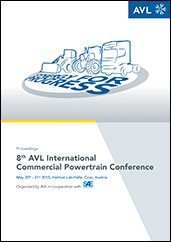Technical Paper
100% LPG Long Haul Truck Conversion - Economy and Environmental Benefits
2012-09-24
2012-01-1983
Advanced Vehicle Technologies (AVT), a Ballarat Australia based company, has developed the World's first diesel to 100% LPG conversion for heavy haul trucks. There is no diesel required or utilized on the trucks. The engine is converted with minimal changes into a spark ignition engine with equivalent power and torque of the diesel. The patented technology is now deployed in 2 Mercedes Actros trucks. The power output in engine dynamometer testing exceeds that of the diesel (in excess of 370 kW power and 2700 Nm torque). In on-road application the power curve is matched to the diesel specifications to avoid potential downstream power-train stress. Testing at the Department of Transport Energy & Infrastructure, Regency Park, SA have shown the Euro 3 truck converted to LPG is between Euro 4 and Euro 5 NOx levels, CO2 levels 10% better than diesel on DT80 test and about even with diesel on CUEDC tests.

